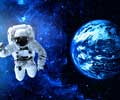A Day at the Lyndon B. Johnson Space Center
On October 2015 at Rio de Janeiro, on the occasion of the annual conference of the International Society for Telemedicine and eHealth, I was there to deliver a keynote address representing India. That was when I first heard a presentation on physiological changes occurring in the Human on exposure to microgravity in a simulated environment. This was followed by many slides that showed what happens to astronauts' bodies in Outer Space.
The icing on the cake was a photograph of the presenter floating in microgravity during a parabolic flight! That was how I first came into contact with Prof Thais Russomano!
My interest was kindled, but living in India I thought Space medicine was irrelevant to us. 3 years later came the announcement from ISRO that the first Human Space Flight Mission from India was a go! I now realized that Space Medicine in India would indeed be a reality even in the lifetime of a septuagenarian! I started reading.
A review article on Neurological changes in Outer Space was followed by bringing out a special supplement on Extra-Terrestrial Neurosciences for the journal Neurology India with articles by Space Scientists and Flight Surgeons. Each of the 14 articles has been downloaded from 1200 to 2500 times within a short span of time. It looks like interest in even such an ultra-focused niche area is being generated and Space Medicine will soon become a reality even in India!
Genesis of Visit to Lyndon Johnson Space Center
Exchange of mails 5 months prior to my visit to the USA made me realize that it may be possible to "gain entry" to the Johnson Space Center, Houston Texas, from where healthcare is provided to astronauts. Thanks to Dr. Teri Mader a contributor to our Special Supplement I was introduced to Dr. William J. Tarver, MD MPH FAsMA, SANS Clinical Lead - CNS and Deputy Crew Surgeon stationed at Johnson Space Center. Dr. Tarver was, to say the least, "Fantabulous". He went out of his way to facilitate all the preliminary paperwork, he was instrumental in getting me into the NASA "IDMax" system and "badged" for this visit. I received a request for specific personal information from NASA. After enclosing copies of my passport, US Visa. Local address, telephone number and other required information, a second email was received. This provided me a unique passphrase for accessing the NASA Identity Invitation Website.
On 17th December 2019 I was at Baylor College of Medicine to give a talk. I found a gentleman "playing" with the AV system and gave him my presentation thinking he was the AV technician. Without batting an eyelid, he loaded my presentation. I later found that he was my host for the next day. Dr. William Tarver (he is indeed an institution by himself) and was most willing to share information that could be shared. I am sure I would not have spent 6.5 hours non-stop taking a visitor around and answering dozens of questions - and realize that he was one of less than 40 true "space doctors" on Terra firma with such super selective clientele!
A Day at the Lyndon B. Johnson Space Center
We were scheduled to meet at 0900 hours at Building 110 at the Lyndon B. Johnson Space Center (JSC) main gate. At 0858 he dropped in and in a few minutes got me "badged". He had warned me earlier that being the week before Christmas, JSC will be in "pre-holiday" mode. Activities would be reduced with fewer staff. As the campus extended for several miles, Bill also provided me with transport. I was surprised to see that he had a sturdy large pick up van which went well with his informal attire. What followed was an amazing tour of multiple buildings, meeting the staff in each of these units. A feeling of bon hommie exuded from every single individual. It was obvious that every individual was truly passionate about what they were doing. None of them were here by accident. They had worked hard to get a placement here. A chain is as strong as its weakest link. Obviously with Humans in Outer Space the entire chain has to be super strong.
A statement by a former Administrator of NASA speaks for itself -. In terms of a number of dollars or men NASA has not been our largest national undertaking, but in terms of complexity, rate of growth and technological sophistication it has been unique - it may turn out that the space program's most valuable spin off of all, will be human rather than technological: better knowledge of how to plan, coordinate and monitor the multitudinous and varied activities of the organizations required to accomplish great social undertakings.
JSC's Role - Located on a 1,620-acre campus the JSC is the hub of NASA's human spaceflight research and oversight activities. The Human Research Program coordinates research and development projects at a number of facilities and test sites across the USA. Scientists and engineers at the JSC conduct studies related to space radiation, exploration of medical capability, microgravity, human factors, habitability, and behavioral health.









